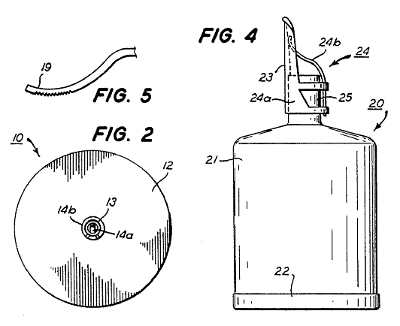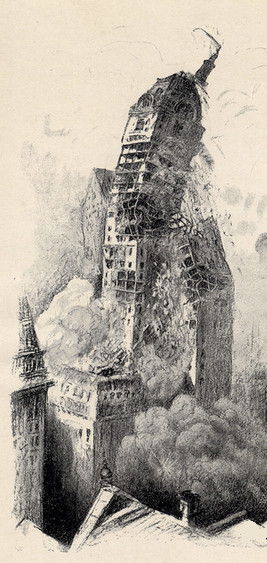oblivescence
n. the process of forgetting
Author: Greg Ross
Mixed Call
Where in the Bible are we told in one verse not to do a thing and in the next to do it?
‘Answer not a fool according to his folly, lest thou also be like unto him.’ Prov. xxvi. 4.
‘Answer a fool according to his folly, lest he be wise in his own conceit.’ Prov. xxvi. 5.
— Samuel Grant Oliphant, Queer Questions and Ready Replies, 1887
Italian to Go

“[B]ecause of the nature of pasta dishes, it has not been practical to eat pasta products while strolling.” Patented in 1990, Nicholas Ruggieri’s “spaghetti sipper” solves this problem with a tidy, portable container:
A person eats the pasta by placing their mouth on the spout 23 or tube 13 and sucking up the pasta. When the desired amount of pasta is obtained, the person bites off the pasta and then consumes the pasta in the usual manner. When the pasta is cut, the pasta in the tube 13 or spout 23 is held in place by the pawl mechanism 14b, 24b. When the person wishes more pasta the sequence is repeated. By use of the pasta server 10, 20 of this invention a person can eat pasta while strolling and the like.
“To the pasta can be added as desired any of a number of sauces traditionally associated with pasta. These sauces typically enhance the lubricious properties of the pasta.”
Falling Angels
A fearful accident happened on Friday last at the Madeleine church, Bruges. One of the priests, while performing mass, was suddenly struck to the ground by the falling on his forehead of the marble head of an infant Jesus, which had become detached from its body. Fracture of the skull and a severe wound were the consequence to the unhappy clergyman, who, after lingering in great agony, died yesterday.
— Times, May 3, 1847
An extraordinary and fatal accident happened this morning in the Roman Catholic parish church of Kildare. As the Very Rev. Dr. J.B. Kavanagh, P.P., was standing in front of the altar with his hand on the chalice to raise it at the close of 7 o’clock mass, and was about to descend the altar steps to recite the Rosary and Litany of the blessed Virgin, the marble figure of a cherub over the altar fell down and struck him with great force on the head. He fell back heavily, murmured the words ‘My God’ twice, and then became insensible. A cry of horror and anguish was raised by the congregation who witnessed the accident. Some persons rushed forward to lift him up, while others ran for medical help. Drs. Watson, Dillon and Chaplin were soon in attendance, and Dr. Kavanagh having been raised from the floor was placed on a stretcher and carried into the adjoining convent, where, having never recovered consciousness, he died soon afterwards.
— Times, Oct. 6, 1886
A Simple Proof
Can an irrational number raised to an irrational power yield a rational result?
Yes. ![]() is either rational or irrational. If it’s rational then our task is done. If it’s irrational, then
is either rational or irrational. If it’s rational then our task is done. If it’s irrational, then ![]() = 2 proves the statement.
= 2 proves the statement.
Welcome to America

Is Ellis Island in New York or New Jersey? Surprisingly, it’s in both. Under a 1934 compact, New York had jurisdiction over the original 3-acre Army fort, but the 24 acres of landfill that have since been added are part of New Jersey. The Supreme Court essentially upheld this arrangement in a 1998 ruling.
“New York still collects sales tax from concessions within the donut hole,” writes geographer Mark Monmonier, “while New Jersey taxes purchases elsewhere on the site.”
Limerick
L is for lovable Lena,
Who met a ferocious hyena;
Whatever occurred
I never have heard;
But anyhow, L is for Lena.
— Anonymous, from Carolyn Wells’ Book of American Limericks, 1925
Bad Starts
The popular Bulwer–Lytton Fiction Contest challenges entrants to compose “the opening sentence to the worst of all possible novels”:
As an ornithologist, George was fascinated by the fact that urine and feces mix in birds’ rectums to form a unified, homogeneous slurry that is expelled through defecation, although eying Greta’s face, and sensing the reaction of the congregation, he immediately realized he should have used a different analogy to describe their relationship in his wedding vows.
Less well known is the Lyttle Lytton Contest, which requires that the sentences be short. Winners:
2012 – “Agent Jeffrey’s trained eyes rolled carefully around the room, taking in the sights and sounds.” (Davian Aw)
2011 – “The red hot sun rose in the cold blue sky.” (Judy Dean)
2010 – “‘I shouldn’t be saying this, but I think I’ll love you always, baby, always,’ Adam cried into the email.” (Shexmus Amed)
2009 – “The mighty frigate Indestructible rounded the Horn of Africa and lurched east’ard.” (Pete Wirtala)
2008 – “Because they had not repented, the angel stabbed the unrepentant couple thirteen times, with its sword.” (Graham Swanson)
2007 – “It clawed its way out of Katie, bit through the cord and started clearing.” (Gunther Schmidl)
2006 – “This is the cipher key for all that follows: |||||| || |!” (P. Scott Hamilton)
2005 – “John, surfing, said to his mother, surfing beside him, ‘How do you like surfing?'” (Eric Davis)
2004 – “This is the story of your mom’s life.” (Rachel Lambert)
2003 – “For centuries, man had watched the clouds; now, they were watching him.” (Stephen Sachs)
2002 – “The pain wouldn’t stop, and Vern still had three cats left.” (Andrew Davis)
2001 – “Turning, I mentally digested all of what you, the reader, are about to find out heartbreakingly.” (Top Changwatchai)
Another favorite, offered by Jonathan Blum in a 2007 freeform contest: “Scaling Everest was, by far, the most amazing and transformative experience of my life. Unfortunately, this is a thesis on context-free grammars.”
Early Warning

Published in 1915, Cleveland Moffett’s The Conquest of America imagined a German assault on the United States in 1921. Moffett had intended the novel as a warning of the importance of military preparedness, and it was quickly forgotten, but one passage would come to take on an eerie significance — an attack on Manhattan:
‘Ah! So!’ said von Hindenburg, and he glanced at a gun crew who were loading a half-ton projectile into an 11.1-inch siege-gun that stood on the pavement. ‘Which is the Woolworth Building?’ he asked, pointing across the river.
‘The tallest one, Excellency — the one with the Gothic lines and gilded cornices,’ replied one of his officers.
‘Ah, yes, of course. I recognise it from the pictures. It’s beautiful. Gentlemen,’ — he addressed the American officers, — ‘I am offering twenty-dollar gold pieces to this gun crew if they bring down that tower with a single shot. Now, then, careful! …
‘Ready!’
We covered our ears as the shot crashed forth, and a moment later the most costly and graceful tower in the world seemed to stagger on its base. Then, as the thousand-pound shell, striking at the twenty-seventh story, exploded deep inside, clouds of yellow smoke poured out through the crumbling walls, and the huge length of twenty-four stories above the jagged wound swayed slowly toward the east, and fell as one piece, flinging its thousands of tons of stone and steel straight across the width of Broadway, and down upon the grimy old Post Office Building opposite.
‘Sehr gut!’ nodded von Hindenburg. ‘It’s amusing to see them fall. Suppose we try another? What’s that one on the left?’
‘The Singer Building, Excellency,’ answered the officer.
‘Good! Are you ready?’
Then the tragedy was repeated, and six hundred more were added to the death toll, as the great tower crumbled to earth.
‘Now, gentlemen,’ — von Hindenburg turned again to the American officers with a tiger gleam in his eyes, — ‘you see what we have done with two shots to two of your tallest and finest buildings. At this time to-morrow, with God’s help, we shall have a dozen guns along this bank of the river, ready for whatever may be necessary.’
In the end J.P. Morgan, Andrew Carnegie, and John D. Rockefeller are held hostage and ordered to raise a billion dollars to indemnify the city. “The Conquest of America is as full of thrills as the most excitable and fearful patriot need ask,” raved the Independent. “If all the prominent Americans named in the tale, as hostages or otherwise, get about the business of preparedness, this invasion will never be.”
“Logic”
Cries logical Bobby to Ned, will you dare
A bet, which has most legs, a mare, or no mare.
A mare, to be sure, replied Ned, with a grin,
And fifty I’ll lay, for I’m certain to win.
Quoth Bob, you have lost, sure as you are alive,
A mare has but four legs, and no mare has five.
— The Panorama of Wit, 1809
